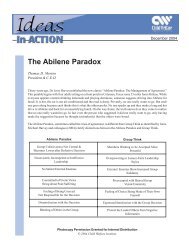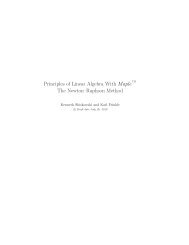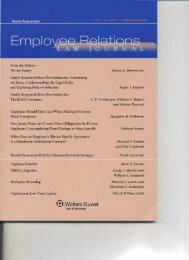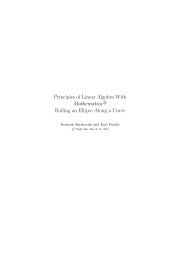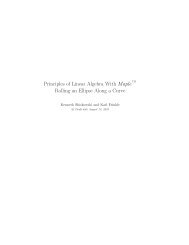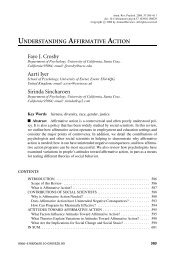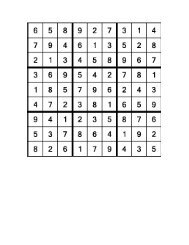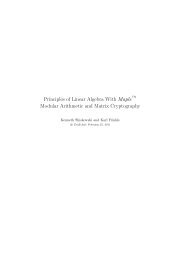Do Nice Guysâand GalsâReally Finish Last - Southeastern ...
Do Nice Guysâand GalsâReally Finish Last - Southeastern ...
Do Nice Guysâand GalsâReally Finish Last - Southeastern ...
Create successful ePaper yourself
Turn your PDF publications into a flip-book with our unique Google optimized e-Paper software.
8 JUDGE, LIVINGSTON, AND HURST<br />
Table 3<br />
Means, Standard Deviations, and Intercorrelations Among Study 2 Variables (Study 2/MIDUS)<br />
Variable M SD 1 2 3 4 5 6 7 8 9 10 11 12<br />
1. College graduate (1 yes, 0 no) 0.69 0.46 —<br />
2. Married (1 married, 0 other) 0.62 0.49 .07 —<br />
3. Hours worked per week 44.14 9.10 .05 .05 —<br />
4. Gender (1 male, 2 female) 1.46 0.50 .03 .22 .29 —<br />
5. Extraversion 2.89 0.55 .07 .01 .07 .01 —<br />
6. Agreeableness 3.31 0.43 .08 .04 .09 .27 .16 —<br />
7. Conscientiousness 3.31 0.43 .05 .03 .02 .09 .40 .30 —<br />
8. Neuroticism 2.16 0.60 .09 .10 .04 .12 .25 .08 .35 —<br />
9. Openness to experience 3.09 0.53 .21 .06 .05 .07 .56 .24 .37 .25 —<br />
10. Continuous work history 22.42 10.86 .06 .10 .07 .13 .01 .02 .11 .14 .01 —<br />
11. Unemployment status 0.01 0.10 .01 .02 .00 .00 .01 .00 .03 .03 .03 .06 —<br />
12. Job complexity 0.05 0.74 .44 .01 .13 .01 .08 .03 .09 .10 .19 .00 .04 —<br />
13. Income 36,010.12 23,916.67 .27 .14 .33 .32 .07 .19 .07 .10 .13 .18 .08 .38<br />
Note. MIDUS National Survey of Midlife Development in the United States. N 1,827. Correlations greater than .05 are significant at the p .05<br />
level. Correlations greater than .07 are significant at the p .01 level.<br />
no), the number of times an individual had been fired (coded as 0<br />
for those reporting never to have been fired), the number of times<br />
the individual was not given a promotion for which he or she was<br />
eligible, and job complexity. In a few cases, agreeableness predicted<br />
these outcomes: Agreeable individuals were slightly less<br />
likely to have been fired from their job ( .08, p .05), and<br />
their jobs were less complex ( .11, p .01). However, in no<br />
case was there a differential relationship of agreeableness with<br />
these variables by gender. Thus, it does not appear that the differential<br />
effects of agreeableness by gender generalize to nonpay<br />
variables, at least within the limits of Study 2 data.<br />
Study 3<br />
Although the previous analyses support the effect of gender and<br />
agreeableness on earnings—and the differential effect of agreeableness<br />
by gender—they do not eliminate two important potential confounds.<br />
It is possible that the results were observed due to occupational<br />
segregation (at least that not captured by job complexity).<br />
Specifically, if men or disagreeable people earn more because they<br />
occupy jobs with greater responsibilities, they may earn more simply<br />
for this fact. Similarly, if men or disagreeable individuals work in<br />
higher status occupations—attorneys and engineers rather than social<br />
workers or elementary school teachers—the earnings advantages enjoyed<br />
by disagreeable men may be confounded with the occupations<br />
they occupy. Accordingly, in Study 3, we sought to replicate the<br />
earlier results, controlling for job responsibility and occupational<br />
status, and to investigate possible mediators and paradoxes underlying<br />
the agreeableness–gender interaction.<br />
Method<br />
Participants and procedure. Participants in Study 3 were<br />
enrollees in the Wisconsin Longitudinal Study (WLS). The WLS<br />
Table 4<br />
Effects of Agreeableness and Sex on Earnings (Study 2/MIDUS)<br />
Overall Men Women<br />
Independent variable<br />
B($) SE B B($) SE B B($) SE B <br />
College graduate 5,979.83 1,126.17 .12 6,948.42 1,774.16 .12 5,297.80 1,274.64 .14 <br />
Married 3,610.23 977.24 .07 7,790.76 1,629.31 .14 762.43 1,067.58 .02<br />
Hours worked per week 527.64 52.96 .20 535.09 75.74 .20 517.54 70.50 .22 <br />
Sex (male 1, female 2) 9,297.16 1,042.10 .19 — — — — — —<br />
Extraversion 153.59 1,051.29 .00 251.80 1,681.28 .01 1,531.21 1,180.05 .05<br />
Agreeableness 7,524.21 1,192.99 .13 10,326.21 1,712.52 .18 3,213.12 1,560.93 .07 <br />
Conscientiousness 3,874.84 1,276.03 .07 4,814.79 1,906.78 .08 2,394.44 1,539.82 .06<br />
Neuroticism 743.35 839.14 .02 1,695.47 1,335.04 .04 184.15 942.77 .01<br />
Openness 1,753.26 1,131.11 .04 4,090.32 1,767.83 .08 1,108.79 1,299.11 .03<br />
Continuous work history 299.43 43.26 .14 329.10 65.79 .14 210.67 52.30 .12 <br />
Unemployment status 13,014.73 4,407.81 .06 21,587.32 6,821.23 .09 3,424.92 5,106.83 .02<br />
Job complexity 9,177.42 696.95 .29 9,414.09 1,023.70 .29 8,537.29 866.55 .33 <br />
Multiple R — — .58 — — .52 — — .54 <br />
R 2 — — .34 — — .28 — — .29 <br />
Note. MIDUS National Survey of Midlife Development in the United States. N (overall) 1,828. n (men) 991. n (women) 837. Em dashes<br />
indicate not applicable.<br />
p .05 (two-tailed).<br />
p .01 (two-tailed).



